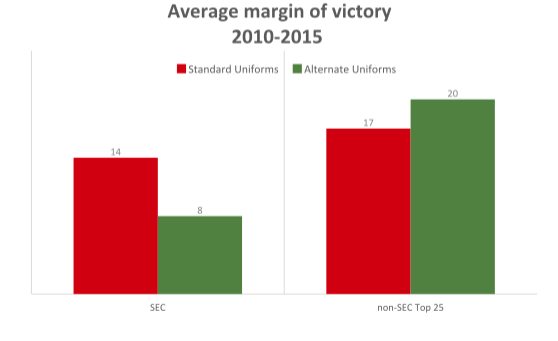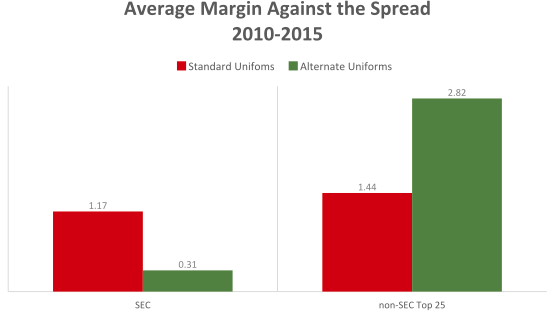Ask any serious Clemson fan about the “Orange Britches,” and you’re sure to see a smile, probably followed up with a story of a favorite game in which the Tigers were victorious while wearing their rare all-orange uniforms. Mention the 2008 “Blackout” game around a devout Georgia fan, and you might not want to hang around for the response. Alternate uniforms have long been used as motivation for players and fans. But sometimes, as Georgia demonstrated, it doesn’t work and may even be a distraction.
Some fans and commentators have forgotten that before Georgia’s infamous Blackout game in 2008, there was the first Blackout game in 2007. In that game, Georgia came out hot and stayed sharp, blowing out a top-25 Auburn team. After the game, then-coach Mark Richt talked about the impact of the uniforms:
“The players have wanted to have black jerseys for years now, and I always resisted. This summer I pulled the trigger and spoke with Nike and they made the jerseys and we targeted them for a game later in the year. I knew it would give us a boost and at least get us a jump start.”
The uniforms did more than reward players who had been asking for the black jerseys. Because rumors of the jerseys ran wild prior to the game, fans came prepared with their own black gear. The result was the kind of synergy and atmosphere that is college football at its best. As Richt said, “It was unbelievable to look into the stands and see what I saw. By the time we kicked off, the whole stands were blacked out. It was a great sign of unity.”
But the very next year, the 2008 Blackout game happened. Instead of riding the energy of the crowd, Georgia, ranked #3, was overwhelmed by #8 Alabama, who raced out to a 31-0 halftime lead. Georgia fought back in the second half, but the damage was already done. Fans and commentators afterward wondered if the Dawgs had been distracted by the uniforms and too hyped to focus on the start the game.
Clemson, which has its own tradition of motivational alternates, has taken a more conservative approach to uniforms the last few years. In 2012, Coach Dabo Swinney discussed his approach: “I really felt like it was a distraction, and I don’t want our uniforms to be a distraction. We have more to worry about than having guys coming in and saying, ‘Hey what are we wearing?’ I don’t have time for that. Let’s focus on the game.”
So which is it, motivation or distraction? With the College Football Uniform Study, we wanted to find out if there was any evidence that alternate uniforms actually impact team performance. We looked at the past six years’ worth of home games for SEC and non-SEC top-25 teams and found some surprising trends. First, SEC teams’ average margin of victory (or defeat) is about a touchdown less when wearing alternate uniforms, but non-SEC top-25 teams win by about a field goal more in alternates.

These trends are based on final-score margins from over 1,200 games, representing every home game for the past six years among teams in our sample, so the differences aren’t a statistical artifact; they’re real. But why?
One possible explanation is hinted at in our previous post. From 2010 to 2015, the use of alternate uniforms more than doubled in the SEC and increased by over 50 percent in the non-SEC top 25. But while high-scoring top-25 powers like Oregon, TCU, and Baylor made alternates their new normal, it was the SEC’s weaker teams like Kentucky and Vanderbilt that embraced alternates. SEC bluebloods like Alabama resisted the change and opted to build their brand on tradition. So maybe SEC teams appear to perform more poorly in alternates because it’s the relatively weaker SEC teams that are taking creative risks with uniform combos.
To check the “weaker SEC teams” hypothesis, we looked at performance against the spread. The spread at kickoff is essentially a crowd-sourced prediction of the game and should take into account the relative strength of the teams, home field advantage, injuries, and even the predicted weather. Thus, the score margins against the spread will be much smaller. But, even when we use performance against the spread, the same trends are evident. When wearing home alternates, SEC teams average about a point (.86) less against the spread, while non-SEC Top 25 teams do over a point (1.4) better.

So, even when the spread takes into account the relative strength of the teams, SEC teams still do worse in alternates and non-SEC top-25 teams do better. Moreover, we found that more than half of the points gained or lost against the spread were scored in the first quarter. This suggests that there may indeed be a motivation or distraction taking place. At the beginning of the game, a team may get a boost from emotion or lose focus because they are overhyped, but after the first quarter, any hype about uniforms is likely to have worn off. Taking all of our findings together, it appears that SEC teams, playing in the land where football traditions are sacred, are more likely to be distracted by alternate uniforms, but non-SEC top-25 teams are more likely to gain an edge from their edgy uniforms.
In our next post, we’ll look at individual teams to see which ones get the biggest boost from alternate uniforms. Check out our website for more details on the College Football Uniform Study.
Written by Charles E. Stokes
General Editor: Macy Marin
Photo credits
UGA v AL 2008: http://www.zimbio.com/pictures/RDx5eaLFUGj/Alabama+v+Georgia/i8GyMTUw4MJ/Eryk+
Anders Clemson v Oklahoma 2015: http://campusinsiders.com/news/orange-bowl-live-thoughts-notes-oklahoma-vs-clemson-fourth-quarter-12-31-2015
